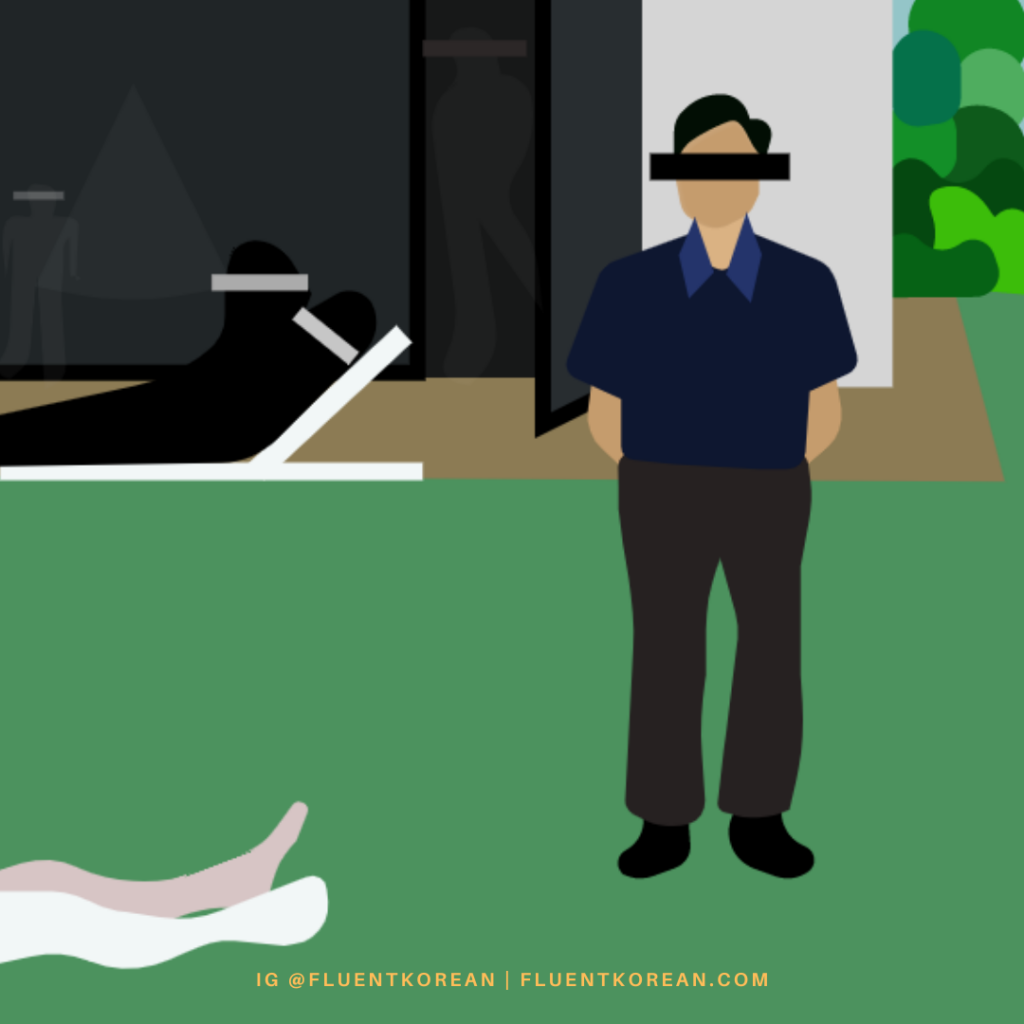
I first saw Parasite last December at an arthouse theater in Michigan called Cinema Detroit. It’s a quaint little theater in the space of a former furniture shop. They have art deco style signs and mismatching furniture, a small theater room, a private screening room, and a whimsical concession shop that sells cola in little glass bottles.
It was my very first time seeing a Korean movie in a theater outside of the peninsula. Looking around the room and seeing that I was the only Asian in the room was surreal.
Cut to a few months later, Parasite wins Best Picture at the Oscars, a first for any non-English film. The film bagged a total of four Academy Awards including Best Foreign Language Film, Best Original Screenplay, and Best Director.
I didn’t drink until next morning but I definitely had a celebratory toast for Korean cinema. We were all Sandra Oh in her poufy dress with proud tears in our eyes, jumping for joy for our Korean brothers and sisters.
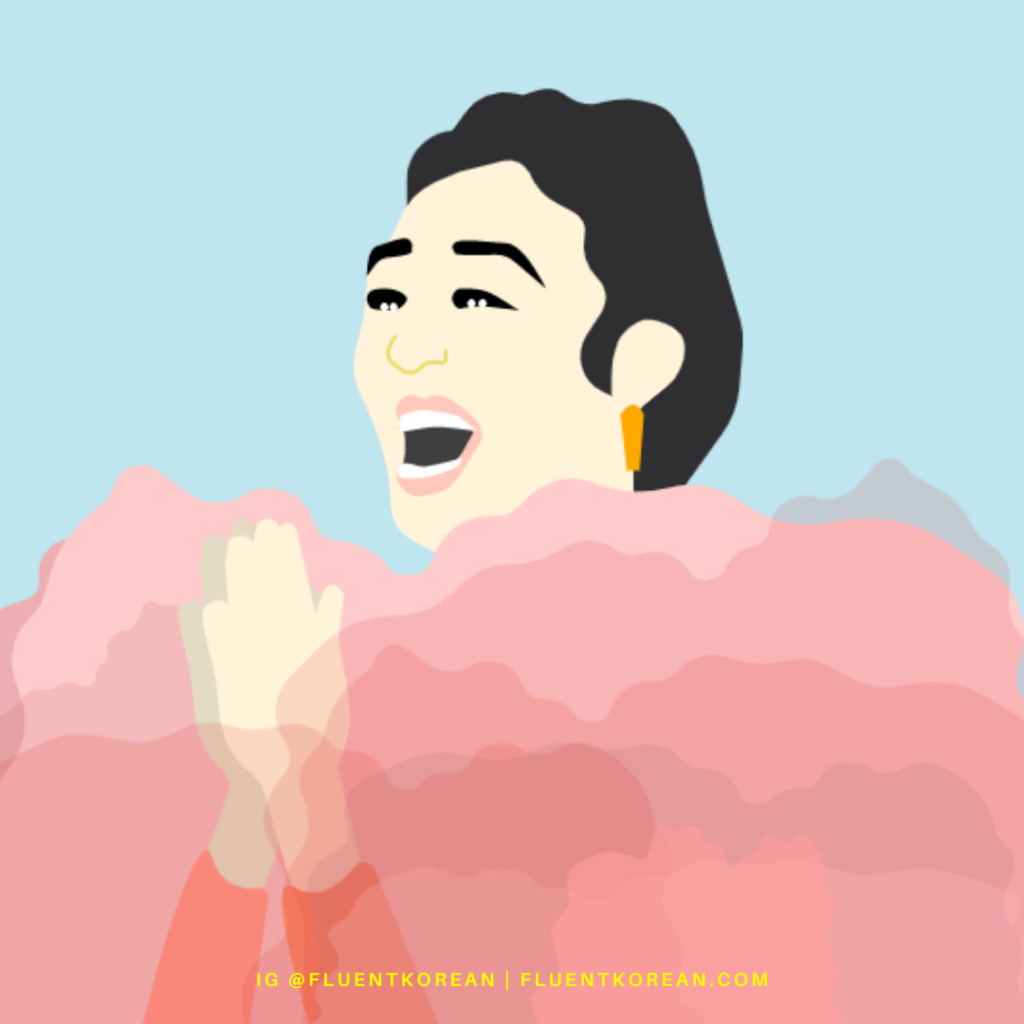
I’m a little late to the backyard garden party in writing this post, but as I’m still pretty much stuck indoors thanks to COVID-19, I decided to give it a shot. It goes without saying, but this post obviously contains a lot of spoilers. If you haven’t seen the film yet, enter at your own risk!
Anyways, since you’ve already overcome the one-inch barrier of text to watch the film, here’s a list of Korean cultural details in Parasite that you might have missed.
SEMI-BASEMENT APARTMENT (반지하)
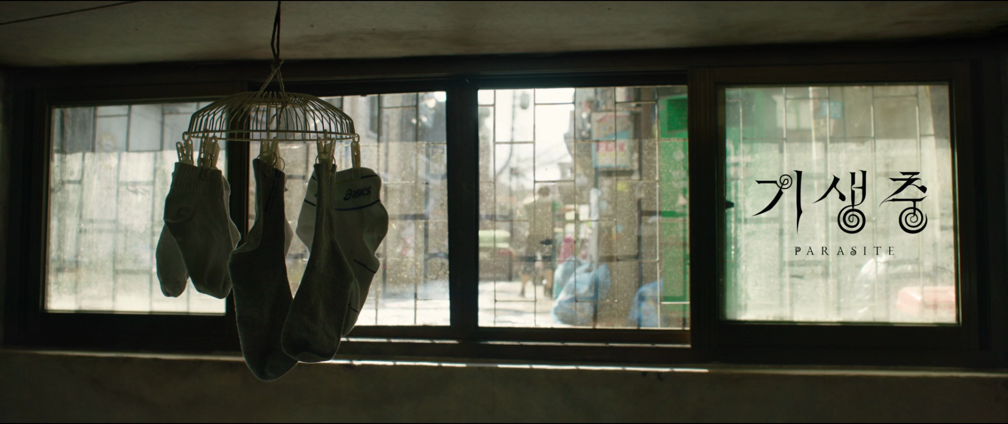
The film begins and ends at the semi-basement apartment or banjiha (반지하) of the Kim family which overlooks a dirty back alley that drunk men use as their toilet.
When I moved to Beijing, one of the things that shocked me was how easily people could move in and out of apartments. Sometimes as often as they changed boyfriends/girlfriends. The downpayment and security deposit were just a couple of months worth of rent. In Seoul, however, the deposit is many, many times the monthly rent. One of my friends who lived outside of the city center paid USD 10,000 as a deposit (you get this back when you leave) for an apartment he paid USD 500 a month for. I’m not even going to explain the concept of jeonse (전세); this is just for those who pay on a monthly basis or wolse (월세).
Semi-basements are one of the most affordable housing choices in Seoul. Their deposits are more forgiving to thin wallets and bank accounts, but it’s really not a comfortable place to live. It’s almost rock bottom and there is some social stigma around it. It’s seen as a stepping stone/starter apartment.
Aside from the obvious reasons, Director Bong chose a semi-basement apartment for the Kim family because of the half-full glass element.1 Yes, you’re underground, but on the bright side, you’re not fully underground. There’s some hope.
The semi-basement is also a parallel to Architect Namgoong Hyunja’s bunker. In the 1970s, at the height of North and South Korean tension, there were a lot of incidences of espionage and terrorist attacks. The government required low-rise building apartments to install basements that could be used as bunkers in the case of an attack.2
Years later, Seoul faced a major housing shortage and the government revised building codes to allow people to reside in the basements.
NAMING CONVENTIONS
Parasite Names

The Korean word for “parasite” is gisaengchung (기생충). Every member of the Kim family has a character in their name that is a homonym to a character in 기생충 – 기택 (Kitaek, the father), 기우 (Kiwoo, the brother), 기정 (Kijung, the sister), 충숙 (Chung Sook, the mother).
Family Names

Bong uses family names as a metaphor for class levels within Korean society. Kim is the most common last name with 21.5% of the population.3 Park is less common than Kim, but it’s still one of the top 3 common last names in Korea with 8.4% of the population.4
Namgoong, on the other hand, is one of the rarest surnames in Korea. Namgoong can be traced back to an ancestor that lived during the Chinese Yin Dynasty (殷/은) which lasted from B.C. 1154 – 1111.
Currently, there are only around a dozen two-character surnames left. This may seem like a lot, but in terms of the quantity, they rank after the 100 most common one-character surnames. As 99.98% of the Korean population have three-character names (monosyllable surname and two-character given names), only 0.02% of the population has a compound surname.
Whereas there are over 10 million Kims and around 4 million Parks, there are only around 21 thousand people surnamed Namgoong.
However, within the list of compound surnames, Namgoong is (at the time of the film’s release) the most common two-character last name.5 Ironically, even with a name like Namgoong, there is someone with a surname that’s even rarer.
I don’t feel like Bong is making commentary on the names themselves. But just in terms of numbers, Kim is the most common. Therefore, the Kim family is the most ordinary. Park is less common, but not extraordinarily unique. The Park family is rich, but they’re nouveau riche. He’s a tech entrepreneur with one company as opposed to a chaebol. They have some wealth, but they wouldn’t top the country’s Forbes list.
His family also doesn’t have a “respectable” background. The fact that his wife is described as “young and simple” means that she also didn’t come from an elite family. Apparently, in order to help her understand her character better, Director Bong told the actress who plays Mrs. Park that she was “young and simple” because she got knocked up when she was a university sophomore or junior. She never really entered the “real world” and tries hard to keep up with her husband.6
Namgoong, however, is presented almost as an intangible cultural asset. His family lineage is like royalty, he’s recognized by the state as one of the best architects in Korea, he’s influential in Paris, and even the housekeeper views the Park family as low-class when compared to the Great Architect Namgoong. Yet, despite the wealth, fame, and status, Namgoong is still insecure about what others would think of his bunker. Which is why, the Parks don’t know the bunker exists at all.
It goes to show that no matter how much you have, there will always be someone who has more.
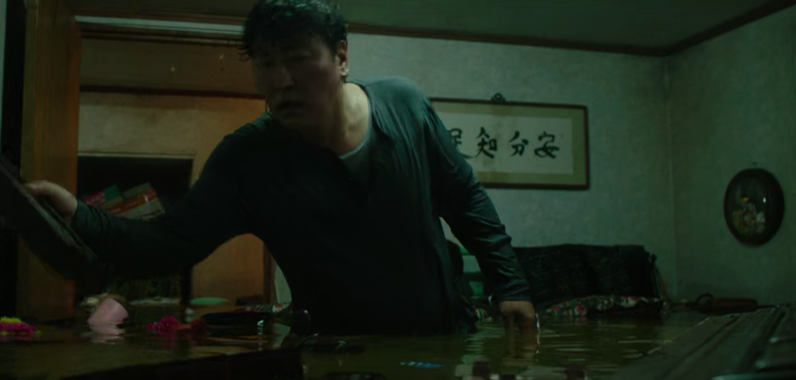
That sentiment is so fantastically contrasted with the painting that hangs in the Kim family home. We see this painting when the Kim siblings and their father return home to the deluge in their half-basement apartment. All of their things are drenched or have floated away. Read right to left, it reads anbunjijok (안분지족, 安分知足). This translates to “happiness lies in contentment.” In other words, be happy with what you have!
Or perhaps the names are all coincidental. Director Bong has said that when he was a student, he had a classmate named Namgoong Min. He had nice skin, was very handsome, and Bong was always jealous of him. There’s also a character named Namgoong Minsu in Snowpiercer.6
Generation Names
Naming offspring using generation names is an old tradition in Korea and China. In Korean, it is called dollimja (돌림자) or hangnyeolja (항렬자). One of the two given names is shared with siblings and paternal cousins of the same generation. Nowadays, the generation name is usually only shared with siblings.7
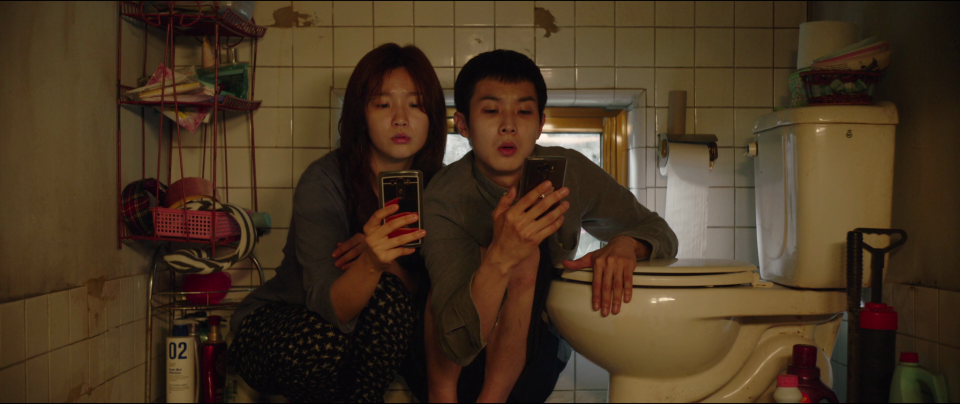
Both the Kim family and the Park family have named their children this way:
- Kiwoo (기우) and Kijung (기정) share the Ki (기) character.
- Dahye (다혜) and Dasong (다송) share the Da (다) character.
In my family, my sisters and I share the character Ju (주) in our names and all of my male cousins on my father’s side have Jae (재) in their name.
MILITARY AND POLITICS
Mandatory Military Service
In 2020, the South Korean military was ranked 6th most powerful in the world.8 This is because, technically, we’re still at war with our comrades in the North.
South Korea has had conscription since the late 50s. All male citizens (with some exceptions – being a BTS member not being one of them) must enlist in mandatory military service between the ages of 18 and 28. Not complying with this law can lead to major consequences such as deportation, public shaming, jail time, becoming unemployable, etc.
It’s kind of like a rite of passage. A friend told me that before the military, he called his father appa (아빠, the equivalent of dad), but once he was discharged, he started calling him abeoji (아버지, a more formal way to address one’s father). His father also treated him more like an adult after he completed his service.
The length of the service depends on which branch of the military one serves. Active-duty soldiers serve 18 months in the Army or the Marine Corps, 20 months in the Navy, 21 months in the Air Force. Non-active duty personnel serves between 21 months 36 months depending on their work. All personnel are provided a stipend during their military service.
There’s definitely a trend of boys enlisting when they don’t have anything going for them at the moment. In the movie, we learn that Kiwoo has completed his service along with four failed attempts at the national college exam. (That makes him 23-24 years old.) I feel like when the economy isn’t doing well, we see news reports of record-high enlistment.
Male college students usually finish their first year or semester in university first (before enlisting) to make friends and create a network. When they come back after two years, they already have friends and acquaintances that can help them integrate back into university life.
The 38th Parallel
The 38th parallel (north) is a line that Americans used to divide Korea into the American-occupied zone and the Soviet-occupied zone later known as South Korea and North Korea. Two American officers used a National Geographic map to determine how to divide a nation. They chose the 38th parallel because it roughly divided the peninsula in half but still kept Seoul in the American-occupied zone.9
In Parasite, Kitaek impresses Dong Ik by shutting off the GPS and saying that he can navigate anywhere below the 38th parallel, i.e., all of South Korea.
North Korean News Anchor

Mun Gwang, the former housekeeper, does an impression of a North Korean news presenter. I must say, it’s pretty spot on. See the YouTube videos below to see the differences between the two standardl Korean accents. Even though we have a lot of regional dialects called saturi (사투리), in the South, the Seoul accent is used for official situations such as news broadcasts. The North’s standard has been greatly influenced by the Pyong’an dialect.
More differences can be found in this post.
South Korean News Announcers
North Korean News Announcer
General Yi Sun-Shin (이순신)

Yi Sun Sin is a national hero and Korea’s most famed admiral and military general. He is best known for his invention of Turtle Ships (거북선) and his victories against the Japanese navy during the Imjin War (1592-1598). It was the only war that samurais fought outside of Japanese land.
Yi Sun Sin innovated the crane wing formation for navy battles called hagikjin (학익진). It’s notable because while this formation was often used on land, it hadn’t been used in battles in the water. The formation was designed to sink enemy ships without losing men on the Korean side.
Here’s a snippet from the Wikipedia article on the Battle of Hansan Island:
The formation itself resembled a “U” shape (thus the crane), with the heaviest battleships in the center and lighter ships on the wings. There was a turtle ship at the end of each side, anchoring the flanks. Reserves were placed behind the central ships and would plug gaps as the formation expanded. Ships at the front of the formation would face broadsides to maximize the number of cannons that would be aimed at the enemy. Furthermore, the “U” shape itself would allow for interlocking fields of fire so that many Japanese ships would be enfiladed and hit from several angles. In this sense the Crane Wing formation shared similarities with the late-19th- and early-20th-century battleship tactic of ‘Crossing the T’. The Japanese tactic was to put their fastest ships in the vanguard to keep the Korean ships occupied, then move their larger ships rapidly to close in, grapple, and board the Korean ships. However, this tactic played right into Admiral Yi’s plan, as the Japanese rowed deeper into the trap. The volume and range of Korean cannon fire prevented the Japanese from employing their favorite tactic and the two wings of the crane formation would envelop, surround and finally have the effect of “crowding in” the Japanese ships, making it difficult to maneuver or retreat and “packing” in the ships and present an easier target for Korean cannons.
– Battle of Hansan Island (Wikipedia)
PUNISHMENT FOR CHILDREN (벌쓰기)

These stress positions where one kneels with their hands up are usually reserved for schoolchildren. Here, the housekeeper and her husband are using this method to humiliate the Kim family.
THE FISH LOCK
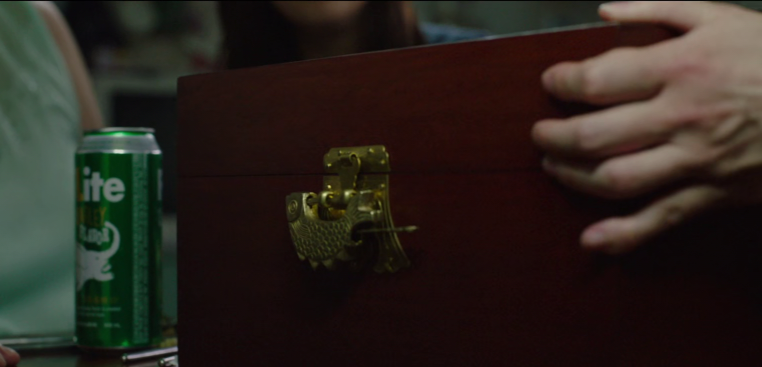
Ancient Koreans believed that locks were talismanic objects that provided spiritual protection as well as wealth, fertility, health, and good fortune. Fengshui or pungsu in Korean (풍수) came into Korean culture during the Unified Silla Dynasty (668-935 A.D.) Followers of pungsu believe the main gate is the most important space with the greatest area of vulnerability in the home. It serves as the entryway for positive energy and keeps evil spirits and danger out. Locks had a functional, ornamental, but also a symbolic role and as such aesthetically, locks were often the central feature of gates, cabinets, wardrobes, and boxes.10
Different shapes represented different types of protection. For instance, turtle-shaped locks were common for main gates because people believed the hard turtle shell represented a shield. Fish-shaped locks were very common for gift boxes and cosmetic cases. With their eyes wide open, they watched over the family’s possessions while they slept. 10
Here’s a step-by-step guide with pictures of how to open a fish lock.
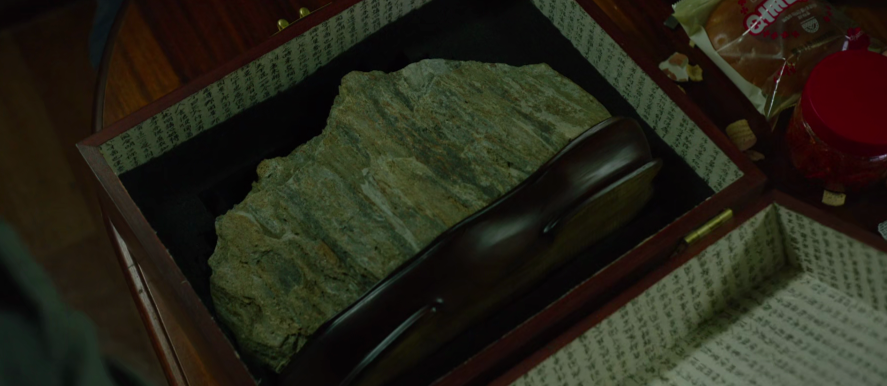
SUSEOK (수석)
There’s definitely a play on words happening here.
Scholar’s Stone/Viewing Stone (수석)
수석 [壽石]: a natural stone with an unusual and beautiful shape, color, or pattern that is mounted for viewing
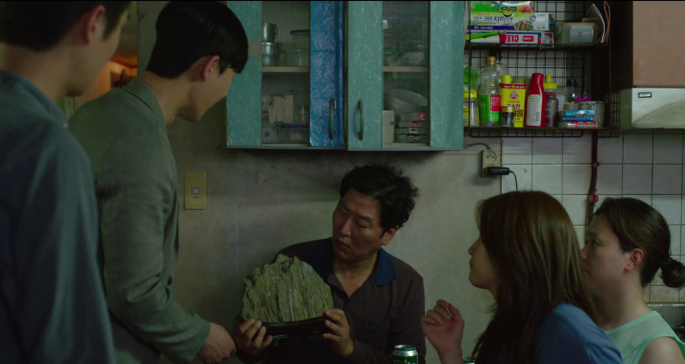
Landscape rocks, known as suseok in Korean, have a deep history in East Asia. The practice of collecting these attractively shaped stones dates back thousands of years, but they became a fixture of Korean society during the Joseun dynasty (1392-1897), when they were commonly displayed on the writing tables of Confucian scholars — hence their other popular English name: “scholars rocks.” Some ancient scholars rocks, or those made from rarer minerals, can fetch astounding sums at Korean auctions.
– Bong Joon Ho Reveals the Significance of ‘Parasite’s’ Scholar Stone (Hollywood Reporter)
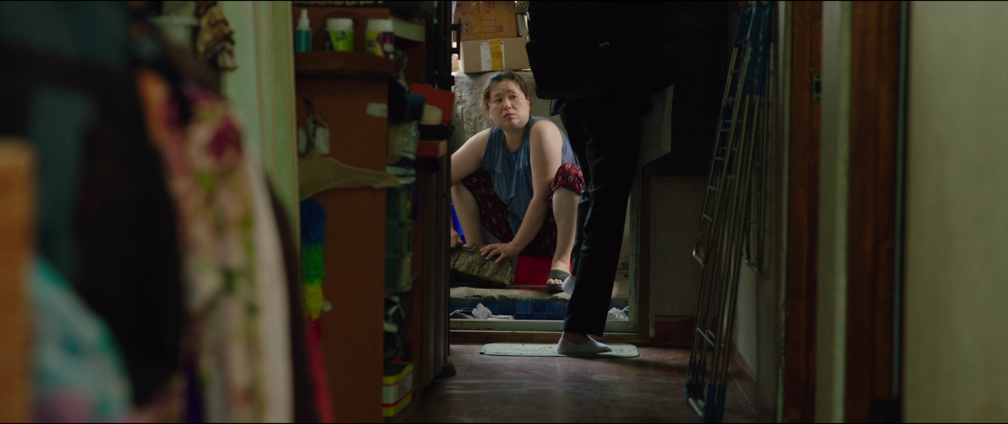
Top of the Class (수석)
수석 [首席]: the top seat referring to the person who ranks first in one’s class

Kitaek remarks that Kijung could be at the top of the class of Seoul National University if they had a forgery major.
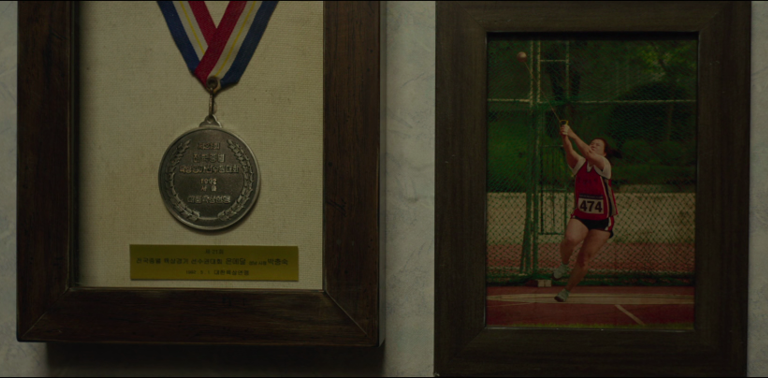
Chung Sook’s medal hanging on the wall is a silver medal. She came really close to the top seat but never makes it to gold.
Chief/Head (수석)
수석 [首席]: the top seat referring to the head or the chief of an organization or department

Even though he says it isn’t, when Mr. Kim drives Mr. Park for the first time, it definitely is a test. Nonetheless, Mr. Kim is a smooth driver and it shows as he doesn’t require GPS navigation and more impressively, he turns a corner without splashing any of Mr. Park’s coffee. Mr. Park remarks, “your cornering is excellent.” This seems like an innocent exchange, but it’s a political joke referencing the scandal involving a former senior Blue House official, Woo Byung-woo, the Head of Civil Affairs or 우병우 민정수석 for the Park Geun-hye Administration.
He worked under the now impeached President Park until 2016 when he faced his own corruption case. His charges included: perjury, abusing authority, and dereliction of duty as a presidential secretary. One of the scandals involved his son, who through his father’s connections, got a cushy and less strenuous driving job for his mandatory military service.11 When the public complained, officials tried to justify their actions by saying his driving skills were smooth and his cornering was great.12
EDUCATION AND COLLEGE LIFE
Hagwon (학원)

Hagwon is Korean for private academies offering extra-curricular education. They’re well known for being cram schools for students to improve their scores and ranking in their actual schools. These institutes can also provide extra training that covers concepts not taught in school or help students who are falling behind catch up.
When we were younger, one of my cousins told me that hagwon was where they actually studied and school was where they hung out with their friends. A lot of parents feel like if they don’t send their children to hagwon, they would fall behind in class. Parents find out about hagwons through word of mouth through the friends of their children.
There are also non-academic hagwon and there is probably an institute for almost anything you want to learn – taekwondo, art, swimming, fashion design, etc. Basically anything you can pad your application with.
There are also hagwon for adults such as for driving, language learning, specific tests such as civil service exams, etc.
Because hagwon are for-profit schools, they can get quite expensive. Parents spend more money on hagwon than any other educational activities for their children. Hagwon also help students get into their top-choice universities. Kijung can’t afford art hagwon so it’s hard for her to enter a top art university even though she has talent.
College Scholastic Ability Test (대학수학능력시험) / Suneung (수능)

Suneung is a matter of life and death for many students. Stress and pressure related to academics are a leading cause of teen suicide in Korea. Many students and their parents believe that one’s performance in this test affects the course of their lives because it determines which universities the test-taker can enter. Academics is incredibly competitive in Korea.
The test is administered once a year. So if a student does not fare well, they can study for another year and try to retake the test. That means they need to push back their plans.
The Suneung is taken very seriously by the whole country. On test day, airplane takeoffs and landings are banned during any listening sections, the stock market, banks, and government offices open late to prevent traffic jams, police vehicles are dispatched to help test-takers get to their venues on time.[NO_PRINTED_FORM] Parents pray in temples and churches and there are groups of people cheering students on as they enter test venues similar to how streets are filled with people cheering on major marathoners.
The test itself is quite hard. Check out an excerpt from the English section below. Now imagine if you had to learn a foreign language and take a test at this level. Crazy.
It’s so difficult that many cram schools train students on how to score high on the exam alongside or instead of the concepts covered in the exam. It’s this kind of teaching method, where Kiwoo grabs Dahye’s wrist to check her pulse like a doctor of traditional medicine, which makes Mrs. Park approve Teacher Kevin on the spot.
SKY Schools

The three most important universities in Korea are the SKY schools: Seoul National University, Korea University, and Yonsei University. Many believe that acceptance to one of these schools is a lifetime ticket to being “set for life”. In the film, Kitaek also mentions how they live in a society where many college graduates are applying for “lowly” security guard jobs. You can watch the Korean drama “Sky Castle” which shows the lengths parents and their children go to enter one of the SKY universities.
A big part of what makes the SKY universities so attractive is the large alumni network. Alumni pride is so strong that even though you didn’t attend school at the same time if you graduated from the same school, you automatically enter an upperclassmen-underclassmen (선배-후배) relationship with that person. These relationships can help you climb ladders and reach a greater network of influential people. Because SKY colleges only accept the best and the brightest, the network is filled with very accomplished and powerful people.
Another detail I noticed was that while there was mention of Seoul National University and Yonsei University, there is no mention of Korea University anywhere in the film.
It’s quite well known that Bong Joon Ho attended Yonsei University majoring in sociology. When Bong won big at the Oscars, Yonsei draped a huge banner on one of their buildings to celebrate his wins. Yonsei University and Korea University have a major rivalry and they have a yearly competition called Yon-Ko Games (연고전) or Ko-Yon Games (고연전) depending on which school hosts it that year. Regardless of who hosts it, Yonsei University students all call it Yon-Ko Games. It’s like a mini-Olympics with many events but with only two competing “nations”. I don’t think the snub was an accident. ?
Jessica’s Doorbell Song

I put Kijung’s jingle under the education sub-heading because she is using the song as a pneumonic device to remember Jessica’s back story. It’s true, Koreans use songs to remember large amounts of information. There’s a song to remember 1000 Sino-Korean characters (천자문/千字文), all of the Korean kings, the periodic table of elements, etc.
The song that her jingle is based on is called Dokdo is Our Land (독도는 우리땅). The song is political but the song is also a pneumonic device. The lyrics of the song itself are a bunch of facts to remember about Dokdo like the address, size, population, etc.
However, the song at its core is a patriotic song about Dokdo being Korean and not Japanese. It’s not a big island, but its significance lies in how it symbolizes Korea’s independence and sovereignty from Japanese colonizers. Dokdo is also home to a lot of natural resources.
The lyrics tell the story of Dokdo.
울릉도 동남쪽 뱃길 따라 팔칠케이(87Km)
외로운 섬 하나 새들의 고향
그 누가 아무리 자기네 땅이라고 우겨도
독도는 우리땅
87 Kilometers along the Southeast waterway of Ulleung Island, there is one lonely island that birds call home. Even though there is one who insists this land is theirs, Dokdo is our land.
경상북도 울릉군 울릉읍 독도리
동경 백삼십이(132), 북위 삼십칠(37)
평균기온 십삼도(13도) 강수량은 천팔백(1,800)
독도는 우리땅
The address is Dokdo-ri Ulleung-eup, Ulleung-gun, Gyeongsangbuk-do, 132 degrees East in longitude, 37 degrees N in latitude, average temperature is 13 degrees Celsius, annual rainfall is 1,800, Dokdo is our land.
오징어, 꼴뚜기, 대구, 홍합, 따개비
주민등록 최종덕, 이장 김성도
십구만 평방미터 칠구구에 팔공오(799-805)
독도는 우리땅
Squid, cuttlefish, codfish, mussel, barnacles, Choi Jongdeok, and village head Kim Seongdo live on the island. 190,000 square meters, postal code 799-805, Dokdo is our land. (Although I think only one person lives on the island now.)
지증왕 십삼년 섬나라 우산국
세종실록지리지 강원도 울진현
하와이는 미국땅, 대마도는 조선땅
독도는 우리땅
In the 13th year of King Jijeung, it was island state Usan. In the geography section of the annals of King Sejong, it was Gangwon-do Uljinhyeon. Hawaii is American land, Daema Island is Joseon land, Dokdo is our land.
러일전쟁 직후에 임자 없는 섬이라고
억지로 우기면 정말 곤란해
신라장군 이사부 지하에서 웃는다
독도는 우리땅 (한국땅)
If one continues to willfully insist it was an owner-less island after the Russo-Japanese War, it makes things difficult. General Lee Sabu of Silla is laughing in his grave. Dokdo is our land. (General Lee Sabu is believed to be the first person to occupy Dokdo Island.13)
Part-Time Jobs (아르바이트)

Botton: “부잣집 과외야. 돈도 많이 줘.”
Areubaiteu (아르바이트), often shortened to alba (알바), is a German loanword which is used very often in Korea. Arbeit is German for “work” but in Korean, it means part-time work. People who do part-time work are called albasaeng (알바생) and are usually in college or around that age. Albasaengs take on work to supplement their tuition or to earn pocket money.
Alba jobs are considered temporary work such as convenience store clerks and bussing tables at restaurants. They’re not considered careers. It’s what you do to earn pocket money while you prepare for a real job in the real world.
If you go to a restaurant in a college area, the waiters and bus boys are usually college students doing alba. However, if you’re a college student in a well-known university, tutoring jobs are an easier way to earn money. They pay more a lot more per hour and you don’t do physical labor.
I feel like the film shows privilege by illustrating how one gets alba positions. In the beginning, Kiwoo is practically begging the pizza store manager for a temp position. On the other hand, the tutoring job is basically handed to him on a silver platter by his “connection”, Min Hyuk.
ANIMAL ASSOCIATIONS
Wolves (늑대) / Frat Boys

Min Hyuk: Look after her while I’m studying abroad.
나 교환학생 가있을 동안 잘 좀 보살펴줘.
Kiwoo: What about your university friends? Why ask a loser like me?
야 너 학교에 친한 과 친구 애들 많잖아 굳이 왜 나 같은 백수한테 부탁을 하냐?
(You have a lot of close friends in your department. Why ask a jobless friend like me?)
Min Hyuk: Why do you think? Just the thought makes me sick. Those disgusting frat boys slavering over Da-hye? It’s revolting.
왜긴 왜겠냐? 난 상상만 해도 너무 싫다. 우리 과 공대생 그 늑대 새끼들이 다혜 근처에 얼씬거리는 자체가 기분이 너무 더러워.
(Why do you think? I hate even the thought of it. Just thinking about my department’s engineering students, those wolves, hanging around her makes me feel dirty.)
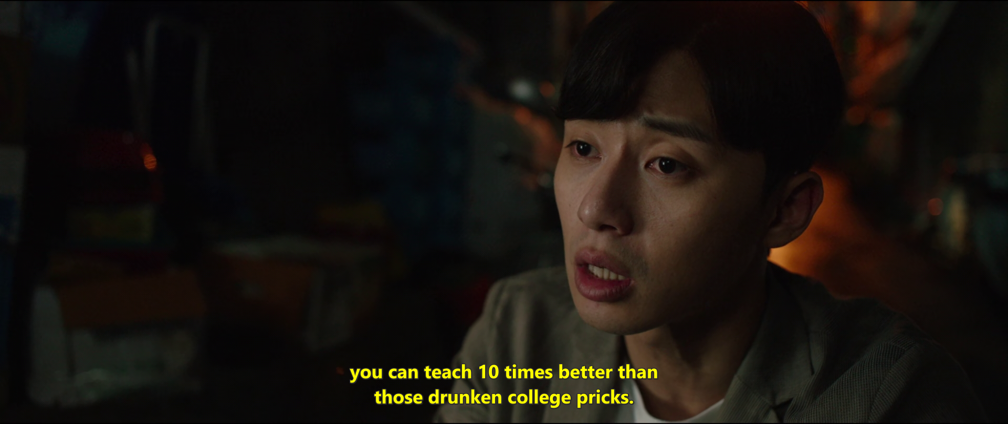
There are a few things to unpack here:
Instead of “loser”, Kiwoo refers to himself as “an unemployed person”.
We hilariously learn that Min Hyuk is an engineering major that is often stereotyped as a department with no women. So in university settings, it’s often male students from the engineering department that’s eager to go on sogaeting (소개팅, blind dates) or “meeting” (미팅, group blind dates) with girls from other majors. Basically, they’re very thirsty.
In the Korean version, Min Hyuk says wolves instead of frat boys. Korean universities don’t really have frats but we have clubs and societies that are kind of like co-ed frats. They’re called dongari (동아리). It’s not just an extracurricular activity, however. Some of these clubs and societies treat their activities as a lifestyle. Relationships from these activities last very very long after graduation. Sometimes the best friends you make in college are not people in your classes, but the people in your clubs.
Wolves are often used in the same way people say “men are dogs” or “men are rats” in English. When I was younger, my dad would say, “men are all wolves, so don’t trust any of them.”
“Drunken college pricks” – The short of it is that Korean college students drink a LOT. High school students study and work towards getting into their dream college pretty much around the clock, so for many students, college life is basically a fun ride before entering the real world. There’s a whole ecosystem that includes MTs (membership training where people drink a lot, play games, and do team building), festivals, a university area filled with bars and clubs, a whole repertoire of drinking games, and a culture that makes it hard to refuse when seniors pour you a shot of soju.
Yellow-Spotted Serpent (눙구렁이) / Old Fox

“생긴 거는 둥글둥글 한데 그 년의 속은 아주 능구렁이야”
She looks round (and harmless), but inside, that bitch is a yellow-spotted serpent.
I find both the yellow-spotted serpent and fox comparison interesting because they both can mean sly and cunning but there are nuances in their associations.
The subtitler uses fox, which is fair, but a fox in Korean culture can have positive and negative connotations. A woman who is able to show off her charm and make herself look appealing can be called a fox. A fox can be sly but they can be artful and crafty as well.
Yellow-spotted serpent or neunggureongi (능구렁이) on the other hand, is a very specific type of sly.14 It’s used to describe someone who plays dumb and pretends to be innocent or a good person but is actually a sly, calculating, and insidious person, which is more befitting Kijung’s assessment of Mungwang, the housekeeper.
White Butterfly (흰나비)

We know Bong Joon Ho strictly follows his storyboards, so the addition of a white butterfly was no accident.
In Korean culture, there are many different associations for butterflies that depends on the color or type of butterfly. During Samjinnal (삼짇날, 三辰日, lit. double-three day), a spring holiday that takes place on the third day of the third lunar month, villagers would go to the mountains for hwaryu nori (화류놀이, blossom tour) to look at flowers and butterflies. If they saw a tiger or butterfly, it would be an auspicious sign for a lucky year ahead. If they saw a white butterfly, it was a death omen. It meant a family member would die that year. White in Korean culture signifies death and mourning.
There’s also a very common children’s song called nabiya (나비야, Hey Butterfly).
나비야 나비야 이리날아오너라
노랑나비 흰나비 춤을추며 오너라
봄바람에 꽃잎도 방긋방긋 웃으며
참새도 짹짹짹 노래하며 춤춘다
Butterfly, butterfly, come fly to me
Yellow butterfly, white butterfly, come dancing to me
In the spring wind, the flowers (petals and leaves) are beaming
Even the birds are chirping and dancing
The lyrics are so happy and I sang it often as a child. I didn’t learn about the symbolism until quite recently. It’s kind of like watching the Disney versions of fairy tales and then reading the source material as an adult.
In the movie, the white butterfly flutters near Oh Geun Sae as he is on a murderous rampage to avenge the death of his wife. He ends up killing Kiwoo’s sister, Kijung. The head of the Park family also meets his demise at the hands of Kim Ki Taek.
Duck’s Bill (오리주둥이)

I grew up when cellphone cameras and selfies were starting to become a thing and with that came the duck face mouth pose trend. I may or may not have participated in this (LOL), but it always made me chuckle because in Korean culture, when you stick out your mouth like that, it’s less of a sexy pout and more of a “you better watch out, you better not cry, you better not pout” type of pout.
In the movie, Park Dong Ik refers to his daughter’s pout as a duck’s bill or orijudeungi (오리주등이). I laughed out loud in the cinema at this part because it reminded me of my own interactions with my mother during my teenage angst years.
FOOD AND DRINKS
Coffee Shops in Korea

There are always new coffee shops popping up whether it’s a chain store or an independent cafe. Some facts about coffee consumption in Korea15:
- South Korea is one of the leading coffee markets in the world.
- Koreans drink 12.3 cups of coffee per week or 2.3 kg of coffee per capita per year.
- There are around 49,000 coffee shops in the country (and growing), of which, more than 18,000 are in Seoul.
- There are more Starbucks in Seoul than in New York.
Drinking at a Convenience Store

Convenience stores and neighborhood marts often have plastic tables with chairs and umbrellas stationed outside. They’re a perfect place to drink because they’re open 24/7 or very late, it’s al fresco, they offer cheap alcohol like beer and soju, you can get snacks as well, you can be as casual as you want, and you don’t need to worry about catching the subway or bus home because you’re usually doing this in one of the many conveniences stores near your house. Convenience stores in Korea are so well stocked that they even sell disposable paper shot glasses for soju.
When I was in college, my friends and I were drinking at a convenience store and I had the urge to drink wine. They sold 10,000 won bottles of wine at the store, but compared to a 1,500 won bottle of soju, it just wasn’t worth it. Instead, my friend bought soju and grape juice and mixed them together. It was so silly, but I think we all laughed for like ten minutes straight. It’s still such a pleasant memory of my college years.
Plum Extract (매실청)

Cheong (청/淸) is a preservation method to make syrups, fruit preserves, marmalade, jams, etc. They are used in cooking as sweetener, seasoning, condiment, as a drink base for tea (e.g., yujacha), alcoholic beverages, etc. The processes vary but it’s usually adding sugar to fruit, sealing it in a jar, and then letting it ferment for a period of time. Maeshilcheong (매실청) is preserved green plum and it’s a folk remedy for coughs, muscle aches, inflammation, and other minor illnesses.
Driver Cafeteria (기사 식당)
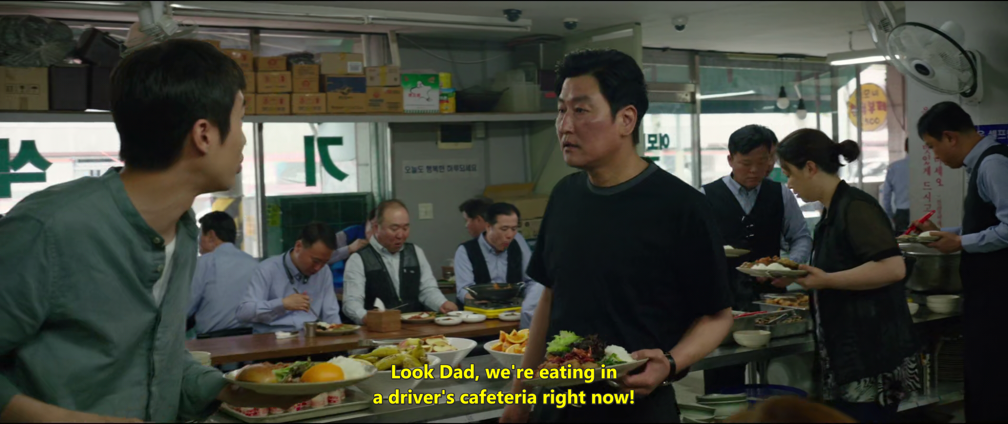
Gisashikdang (기사식당, 技士食堂) are 24-hour restaurants the service bus and taxi drivers. Because of their target market, they’re often located at the start or endpoint of bus routes or near gas stations. Parking space is essential, so these restaurants are usually located outside of the city center where it’s cheaper. Driver cafeterias often look like an old house surrounded by empty lots. The restaurants are inexpensive and serve home-style simple meals such as soups, rice set meals, bibimbap, noodles, and stews. Many allow non-drivers to dine, but some don’t accept the general public. In the movie, the Kim family eats out at a driver cafeteria as they discuss the plan to install Kitaek as the Park family driver.
ANNUAL HEALTH EXAMS (건강검진)
There are many types of health checkups that are available to Koreans, but if you’re enrolled in and pay national health insurance (which most people are), the general public receives a free annual comprehensive health exam once every two years. If you’re male, it’s every odd year and if you’re female, it happens every even year. In the Korean identification system, men’s numbers start with an odd number and women’s numbers start with an even number.
When Kitaek “catches” housekeeper Mungwang in the hospital, he tells Mrs. Park that he was there to get his annual exam. Parasite was released in 2019, so it was definitely his year to get his free exam.
YELLOW JACKETS (민방위복)

If you’ve been watching Korean news coverage on COVID-19, you will find the President and other officials are wearing yellow jackets. Whenever there’s a disaster or crisis (natural or otherwise), high-level officials wear minbangwibog (민방위복) or the Civil Defense Corps Uniform. This tradition was started in 1975 when the Civil Defense Corps was established. At the time, it was in khaki, but since then, it has been changed to a lime color jacket. Officials say that when you wear the lime-colored jacket, you feel a greater sense of duty and responsibility towards the citizens you are helping. At the same time, people can feel a sense of safety when they see someone in a yellow jacket because help is here or on the way. Governments and media keep track of how many times a president wears this uniform during their term.
In the movie, when the Kim family and their neighbors are evacuated from the flood, you can see who the officials are based on their yellow clothing.
MEDIA AND CONNECTIVITY
iptime

This moment gave me such nostalgic flashbacks to when I was a college student in Seoul and sometimes relied on the kindness of iptime strangers. Thank you, neighbors! I think many people can relate to this. Go anywhere in Seoul and you will find an iptime network. It’s usually from people who don’t know how to change the default name of their modem and they probably don’t have a WiFi password.
KakaoTalk / WhatsApp

The subtitler used WhatsApp to make it easier for the English language audience to understand, but KakaoTalk is the most popular and prominent messaging service in Korea. It is used by 97% of smartphone users in the country.16 Aside from sending messages and stickers, KakaoTalk also offers in-app services like online banking, food ordering, and taxi-hailing.
PC Bang / Internet Cafe
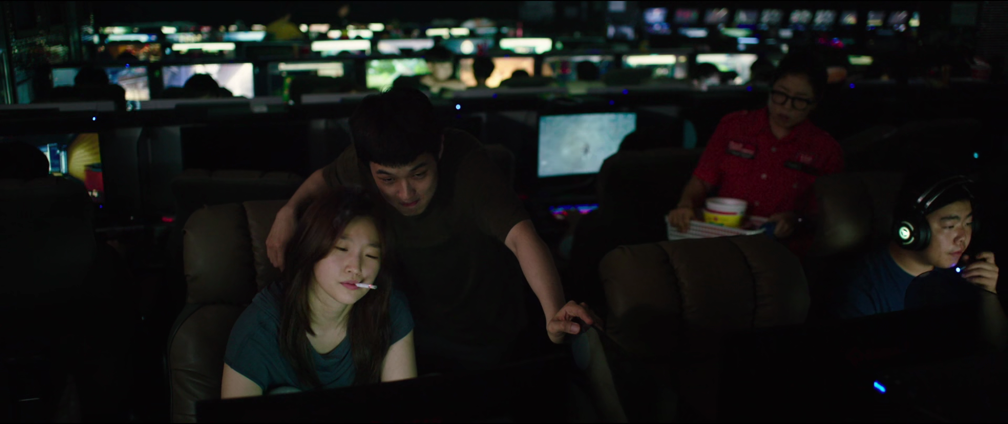
Kijung and Kiwoo head to a PC bang (internet cafe) to forge a Yonsei University certificate. Korea already has one of the highest internet speeds in the world. But where do you go when you need your internet to be even faster? That’s right, a PC bang. Bang (방) means “room” in Korean. Kijung and Kiwoo go to one because they need the computers, Photoshop software, and the fast internet needed to get their forgery done professionally. Aside from gaming on a super speedy network with a lot of pre-installed games, Koreans go to PC Bangs when they need to get competitive. That is, when you need to buy tickets that you know are gonna get sold out in five seconds. When you need to register for college courses that are super popular. Refresh refresh refresh … click click click!!!
They also have really good snacks.
And that’s the list! There were so many that I had to remove a lot of items on the list.
(Read about some of the other details here: Taiwanese cake shops, Jjapaguri/Ramdon noodles)
This film was amazing from the first viewing. The more times I watch it, the more I realize that it’s the little details that make it exemplary. It’s no surprise that one of Bong Joon Ho’s nicknames in Korea is Bongtail (봉테일), a portmanteau of “Bong” and “detail”.
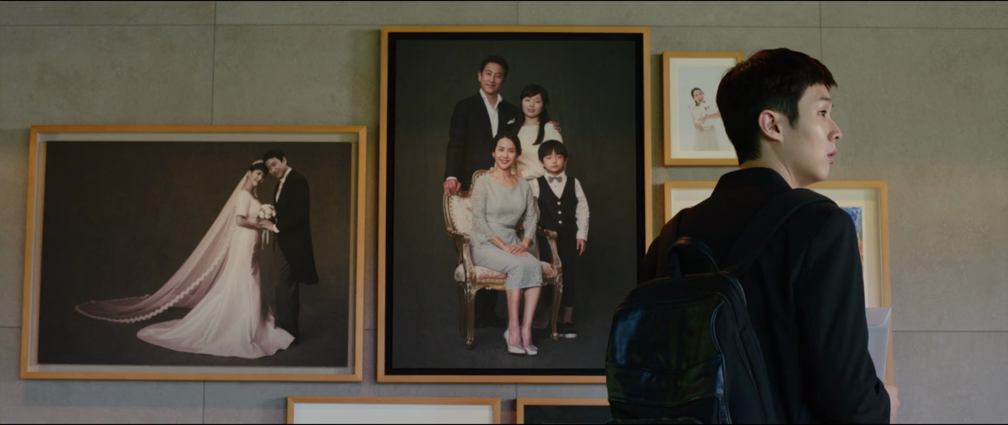
REFERENCES
- 1.“Parasite” Director Bong Joon-ho Breaks Down the Opening Scene. Vanity Fair. November 2019.
- 2.Parasite: The real people living in Seoul’s basement apartments. BBC. https://www.bbc.com/news/world-asia-51321661. Published February 10, 2020.
- 3.Kim (Korean Surname). Wikipedia. https://en.wikipedia.org/wiki/Kim_(Korean_surname).
- 4.Park (Korean Surname). Wikipedia. https://en.wikipedia.org/wiki/Park_(Korean_surname).
- 5.남궁. Wikipedia. https://ko.wikipedia.org/wiki/%EB%82%A8%EA%B6%81.
- 7.Generation Name. Wikipedia. https://en.wikipedia.org/wiki/Generation_name.
- 8.South Korea Military Strength (2020). Global Fire Power (Power Index). https://www.globalfirepower.com/country-military-strength-detail.asp?country_id=south-korea. Published 2020.
- 9.Division of Korea. Wikipedia. https://en.wikipedia.org/wiki/Division_of_Korea.
- 10.Haruhara Y. The Key to Joseon Times. The Japan Times. https://www.japantimes.co.jp/culture/2008/11/06/arts/the-key-to-joseon-times/. Published November 6, 2008.
- 11.Choi J. Woo Byung-woo: One Who Must Not Be Forgotten. Korea Exposé. https://www.koreaexpose.com/woo-byung-woo-park-geun-hye-aide/. Published May 1, 2017.
- 12.최현준. 코너링을 굉장히 잘한다는 우병우 아들의 최신 근황. Huffington Post. https://www.huffingtonpost.kr/2017/03/13/story_n_15333598.html. Published March 13, 2017.
- 13.이사부. 나무위키. https://namu.wiki/w/%EC%9D%B4%EC%82%AC%EB%B6%80.
- 14.능구렁이. Encyclopedia of Korean Culture. http://encykorea.aks.ac.kr/Contents/Item/E0013327.
- 15.The South Korean coffee market, one of the leading markets in the world. Coffee Business Intelligence. https://coffeebi.com/2019/03/13/south-korean-coffee-market/. Published March 13, 2019.
- 16.Chan J. Explained: The Unique Case of Korean Social Media. Linkfluence Blog. https://www.linkfluence.com/blog/the-unique-case-of-korean-social-media.




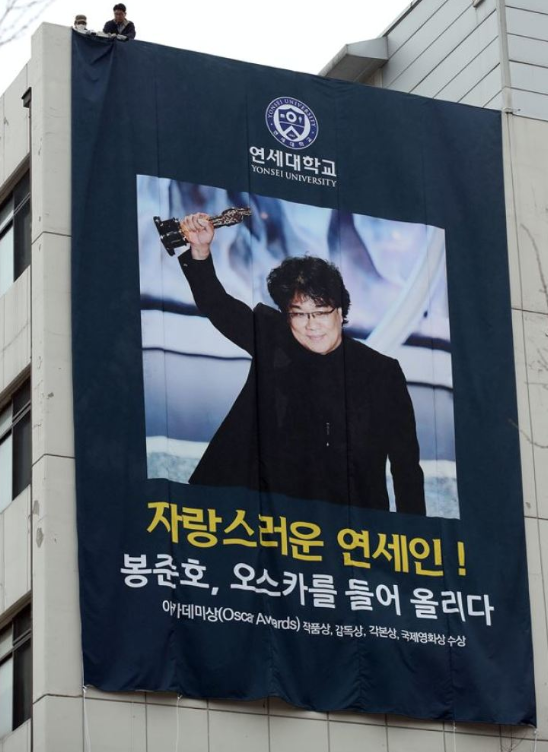


This is a brilliant break down of the cultural references. I’m an Australian born Korean with terrible Korean language skills but I do have interest understanding the culture. Thank you!
Hi Jullietta, thanks for reading and leaving a comment! 화이팅 on your Korean language and culture journey. 🙂